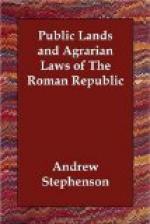[Footnote 14: Long, I, 183; Ihne, IV, 387; Lange, III, 10-12; Nitzsch, Die Gracchen, 294 et seq.]
[Footnote 15: Plutarch, Tib. Grac., 14; Florus, II.]
[Footnote 16: Cicero, De Amicitia, 12. “Tiberius Gracchus regnum occupare conatus est vel regnavit is quidem paucas menses.”]
[Footnote 17: Momm., II, p. 417.]
[Footnote 18: Professor Long thinks that the law of Tiberius soon became a dead letter. Lange (Roem. Alter., III, 26-29), inclines to this view. Duruy (II, 419-420), and most other modern writers agree with Mommsen.]
SEC. 12.—LEX SEMPRONIA GAIANA.
Gaius Gracchus really enacted no new agrarian law but merely re-established the power of the commission which had been appointed by his brother ten years before; which power they had lost by the law of Scipio.[1] Gaius’ law was enacted merely to preserve the principle, and the distribution of land, if resumed at all, was on a very limited scale. This is made known from the fact that the burgess-roll showed precisely the same number capable of bearing arms in 124 and 114. As has already been stated, the domain land had been exhausted by the commission before losing its power, and, therefore, Gaius had none to distribute.[2] The land held by the Latini could only be taken into consideration with the difficult question of the Roman franchise. But when Gaius proposed the establishment of colonies in Italy, at Tarentum and Capua, whose territories had been hitherto reserved as a source of revenue to the treasury,[3] he went a step beyond his brother and made this also liable to be parcelled out; not, however, according to the method of Tiberius, who did not contemplate the establishment of new communities, but according to the colonial system. There can be little doubt that Gaius designed to aid in permanently establishing[4] the revolution by means of these new colonies in the most fertile part of all Italy. His overthrow and death put a stop to the establishment of the contemplated colonies and left this territory still tributary to the treasury.
[Footnote 1: Scipio must have caused a plebiscitum to be enacted, for the repeal of this clause, as an existing law could not be repealed by a senatus consultum. See Ihne, IV, 414, note.]
[Footnote 2: Momm., III, 137.]
[Footnote 3: Cicero, De Leg. Agr., II, c. 29-32; Marquardt u. Momm., Roem. Alter., IV, 106: “ager publicus mit Ausnahme einiger dem Staate unenbehrlicher Domainen, wozu namentlich das Gebiet von Capua und das stellatische Feld bei Cales gehoerte.”]
[Footnote 4: Ihne, IV, 438-479. Plutarch, Gaius Gracchus, 13.]
CHAPTER III.
SEC. 13.—LEX THORIA.[1]
According to Appian, during the years which followed the death of Gaius Gracchus up to the tribunate of Saturninus, that is to say, between the years 120 and 100, three agrarian laws were proposed and adopted.




